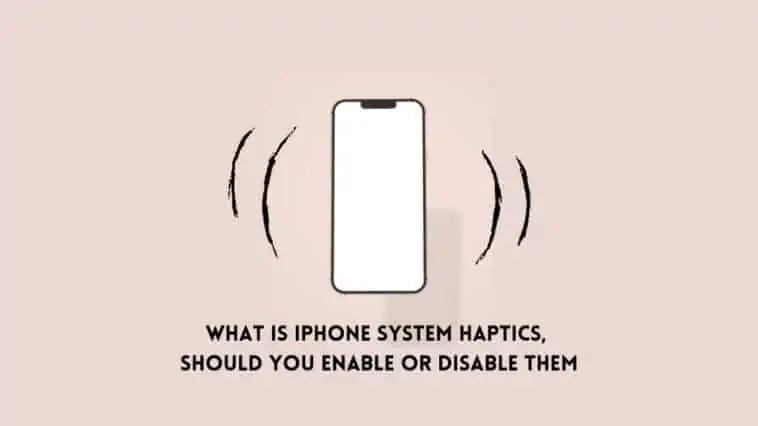Ever wondered about your iPhone’s vibrations? Check out our guide on What is iPhone System Haptics, should you enable or disable them?
iPhones have the best of the best features. With excellent displays, the fastest performance, premium build, and top-notch software, iPhones also tend to nail the small details that make them amazing. One such detail is the haptic feedback, a feature that I love.
Since the iPhone 7, all iPhones have had haptic feedback, which lets you feel vibrations that simulate the feel of clicking a real button. For iPhones with home buttons, it was present in the buttons while newer models have a Taptic Engine that you feel across the screen.
This article will cover everything related iPhone and its Haptics System. Read on to know more about What is iPhone System Haptics, should you enable or disable them?
Related: What is Apple’s LiDAR Scanner?
What is iPhone System Haptics, should you enable or disable them?
Table of Contents
Which iPhones and Apple devices feature Haptics?
On the following Apple products, the Taptic Engine provides haptic feedback:
Apple iPhones
- iPhone 7 Series
- iPhone 8 Series
- iPhone X Series
- iPhone XS Series
- iPhone 11 Series
- iPhone 12 Series
- iPhone 13 Series
- iPhone SE 2
- iPhone SE 3
Apple Watch
- Apple Watches Series 1
- Apple Watches Series 2
- Apple Watches Series 3
- Apple Watches Series 4
- Apple Watches Series 5
- Apple Watches SE
- Apple Watches Series 6
- Apple Watches Series 7
MacBooks
- MacBooks with Force Touch trackpads
Accessories
- Magic Trackpad
Difference between Haptic Feedback and Haptic Touch
Haptic feedback is the tap-like feeling that you experience when you are navigating through your iPhone, like when you toggle settings, using Apple Pay, and more.
Haptic Touch, on the other hand, is a feature that lets you access quick action menus on your iPhone by touching and holding on items.
For example, when you long-press on an app icon on your iPhone’s Home Screen, you will feel a vibration after which the quick options menu will appear, this is function is known as Haptic Touch. You can use Haptic Touch for other menus and options across your iPhone.
So basically, Haptic Touch is a feature that lets you open a quick options menu, while Haptic Feedback allows you to feel vibrations when using your iPhone. Continue reading this guide on What is iPhone System Haptics, should you enable or disable them to know more.
What is iPhone System Haptics?
Haptic Feedback generates the touch like feel sing vibration motors in your iPhone. They can be a single tap or a succession of taps. The intensity of vibration can vary for different functions and for different iPhone models. It is a really cool feeling.
You can disable haptics if you don’t like them, but some users have reported online that turning off System Haptics doesn’t change anything on their iPhones. This is usually because System Haptics are subtle and feel like a natural tap.
There are many different system haptics, here are some of the most popular ones.
Pinch-to-zoom: This feature lets you zoom in/out by pinching your iPhone. You can either move two fingers towards each other or apart from each other to zoom in/out respectively. When you do this you will feel a subtle tap as you reach the minimum and maximum zoom levels.
Volume Slider: Using the volume control buttons on your iPhone also triggers haptic feedback. When you increase or decrease volume your iPhone will vibrate for every level change.
Shake to Undo: The shake to undo feature will undo anything when you shake your iPhone a couple of times. When you use this feature, your iPhone will vibrate twice.
Burst Photos: Burst photos allows your iPhone to capture 10 images per second. When you take burst photos, you will feel a gentle tap.
Toggles: The iPhone Settings app contains toggles that allow you to control various settings. When you turn to interact with a toggle, you will experience a little tap. This includes the on/off toggles for other built-in apps.
Control Center Sliders: You can find two sliders in your control center: Volume and Brightness. When you drag these sliders into Control Center, you will notice small taps as you drag them up or down.
iMessage effects: Message effects are a feature of iMessage. System Haptics are incorporated into iMessage Screen Effects. For example, sending a fireworks effect will result in several vibration taps.
Keyboard: To make typing feel more realistic, your iPhone will vibrate every time you press a key. This makes typing more pleasurable.
Rearrange iMessage: You can have multiple iMessage apps open at once. You will feel a tap when you reorganize these iMessage apps.
Rearrange Home screen: Rearranging Home Screen apps and widgets will also result in taps.
Mail pull to refresh: You can check for new emails with a pull-to-refresh gesture and when you pull down a lot, you’ll experience a subtle vibration tap.
Mute Switch: One of iPhones coolest features is the Mute Switch. You can use this switch to toggle between ring and silent mode on your iPhone and if you switch to Silent Mode, you will hear two gentle taps. Turning this off does not bring up a tap.
App Switcher: If you force close all apps on your iPhone, then when you try to open App Switcher, you feel gentle taps to let you know that all apps are closed.
Number selector for time, and date: When you are in the Clock app, you will feel multiple taps when you spin to select the number. This happens in the Calendar app too.
Camera: The iPhone camera and its app are some of the most advanced on any smartphone. You can take Portrait, Panoramic, Slo-mo, and other cool modes with the iPhone camera. Whenever you switch between a mode, you will feel gentle taps. And whenever you take a picture, you will feel a powerful tap which just feels awesome. This works for videos as well.
AirDrop: When you send a file through AirDrop, you will feel gentle Haptic taps.
Flashlight Brightness Control: When you adjust the brightness of your iPhone’s flashlight through the Control Center, you will feel Hptic taps as you adjust the slider up or down.
Does Haptic Feedback drain Battery?
Since haptic feedback requires a small motor known as the Taptic Engine, it is sane to be concerned that it might drain your iPhone’s battery. But you don’t have to worry about it. Apple created the Taptic Engine to be extremely efficient.
So even if the Taptic Engine uses some energy to work, it won’t affect your battery life significantly. But if you are someone who doesn’t like haptic feedback then you can disable it for a small increase in battery performance, a few percentages at max.
Check out the next section on how to disable haptic feedback on your iPhone.
How to Disable Haptic Feedback on your iPhone
If you don’t enjoy the haptic feedback feature of your iPhone, if you find it distracting and irritating then you can disable it. Disabling haptic feedback might even increase battery life slightly.
There is no straightforward way to disable haptic feedback, as disabling it will disable some other system functions as well. Here are two ways to disable haptic feedback on your iPhone.
Turn off System Haptics on your iPhone
Step 1 Open the Settings app on your iPhone.
Step 2 Tp on Sound and Haptics.
Step 3 Scroll down and toggle the switch next to System Haptics to disable it.
This will disable all of your iPhones haptic feedback, which means your iPhone won’t provide haptic taps for anything, even when you are entering incorrect passcodes or tweaking settings.
Turn off all Vibrations on your iPhone
If you don’t want any vibrations whatsoever on your iPhone, then you can disable all vibrations including haptic feedback using this method. Just follow these steps,
Step 1 Open the Settings app on your iPhone.
Step 2 Tap on Accessibility.
Step 3 Now, tap on Touch.
Step 4 Scroll down and disable the Vibration option.
This will disable all vibrations on your iPhone, including phone calls and message notifications. So think before you disable these options you might lose a lot of functionality.
How Can I Make my iPhone Haptics Stronger?
To change the haptic strength of your iPhone, follow these steps,
Step 1 Open the Settings app.
Step 2 Go to Accessibility.
Step 3 Scroll down and click on Touch.
Step 4 Tap on 3D & Haptic Touch.
Step 5 Drag the slider to increase or decrease the sensitivity as needed.
Why is my iPhone Buzzing When I Press the Home Button?
There could be two causes if your iPhone continues to vibrate whenever you press the home button. I have examined both.
Bug or Glitch
Restarting your phone should help because you might be experiencing an isolated bug. Simply click the Power button on the iPhone 7 and previous models, then move the power slider once it displays. Press and hold the power button for a few seconds to turn it back on.
On the iPhone 8, simultaneously press the power and volume down keys. When the slider shows on the screen, drag it. To switch it back on after a little delay, press and hold the power button.
If the restart didn’t work, go ahead and force a reboot. In essence, force-rebooting is a more thorough option that would abruptly end all operating programs and processes.
Each iPhone model’s force reboot procedure is unique.
Do the following on your,
iPhone 8: Volume up and down buttons should be pressed and then released. Up until the Apple logo appears, keep pressing the side (power) button.
iPhone 7 and 7 Plus: Press the Volume Down and Power buttons together until the Apple logo shows.
iPhone SE and 6S: Hold down the Home and Power buttons until the Apple logo appears.
Broken Taptic Engine
The taptic engine may be broken or loose. If you didn’t know, the taptic engine is located directly beneath the home button. Because you dropped and cracked your phone, it might be behaving up.
You may attempt to fix it yourself, but I suggest leaving it in the hands of the experts at your neighborhood Apple store. Depending on the terms of your warranty, they might fix the problem for free.
Open your screen, then tighten the taptic engine’s screws and bolts if you want to handle the issue yourself. Just bear in mind that if you don’t know what you’re doing, this might be harmful.
Should My System Haptics be On or Off?
The answer, however, varies depending on who you ask. While system haptics does use some battery power, it uses very little in comparison to other iPhone processes.
You might as well turn the feature off right now because it is so subtle. If it were on, you probably wouldn’t notice the difference, and you’ll also be able to save some power.
What is iPhone System Haptics, should you enable or disable them – Conclusion
The System Haptics on iPhone is something special in my opinion. No other smartphone does haptics and vibrations as well as iPhones. There is something that is immensely good about the Taptic Engine and how it works in an iPhone.
The feeling is just right and I love it. It really does feel like interacting with real buttons. While I love it and many people do, it doesn’t mean everyone does. There are people who dislike and find the vibrations irritating. So we have included a section on how to disable haptic feedback too.
This guide on What is iPhone System Haptics, should you enable or disable them has covered everything regarding iPhone and its Haptics, so hope you find it helpful.
Also Read:
A hardcore Apple fan with a collection of
All series of Airpods
All series of fake airpods from China
All series of Apple watches
One Macbook Pro
One iPhone 13 Pro, one iPhone XR, one iPhone 7


